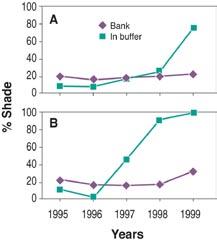
2 minute read
Complex forest
Important Timber Management Tool, PNW 184 (page 23) for information about thinning.
Complex forest
Advertisement
“The high end produces multiple values.” When objectives include longterm stream protection, wildlife habitat and diversity, recreation, and even wood production, the strategy can be to establish a more complex forest with several tree species, shrubs, and other vegetation (Figure 5e). This type of tree buffer is considerably more difficult to establish, but the additional values generated may be worth the extra effort. Leaves from a mixed stand of conifer and hardwood species will support a more complex food chain of aquatic life than a single-species buffer. A more diverse plant community will support more species of wildlife. Recreational features such as picnic sites can be added. Be forewarned that this approach requires extra effort and more skill to carry out. For example, different trees with different growth rates will require planting at different spacings. Clumps of conifers should be planted no closer than 15 feet to fast-growing hardwoods. Fast-growing hardwoods can be planted close to the stream to provide shade in only a few years, while slow-growing conifers are placed away from the stream since they eventually grow taller than the hardwoods. Desirable shrubs or grasses may be added to replace blackberries or other invasive species. If recreation sites are to be included, buffers should be designed to fit the type of recreation planned. For example, if fishing is an objective, keeping the streambanks open and accessible is important. The buffer type selected will make a big difference in the benefits and when they
One-row buffer
Six-row buffer Figure 6. The percentage of a sunny summer day that a riparian area in the Oregon Coast Range is shaded. Shade-time percentages are related to the location and age of the buffer trees in (A) a one-row buffer and (B) a six-row buffer. Shade provided near the stream (purple line) for the first 2 years (for the one-row buffer) to 4 years (for the six-row buffer) was provided by the tall grass that grew after livestock were fenced out. Shade under the buffer trees (green line) rose to over 80 percent in the fourth year after planting (B). In the fifth year, the six-row buffer began to shade the stream as the trees grew tall enough to cast shade some 10 to 15 feet from the edge of the buffer rows. Establishing buffers closer to the stream would provide more shade to the stream in a shorter time. Note the six-row belt provided more shade earlier than the one-row buffer.



